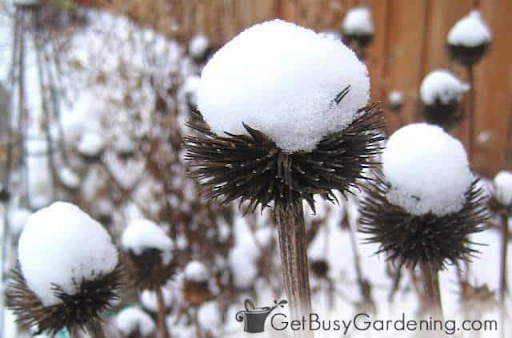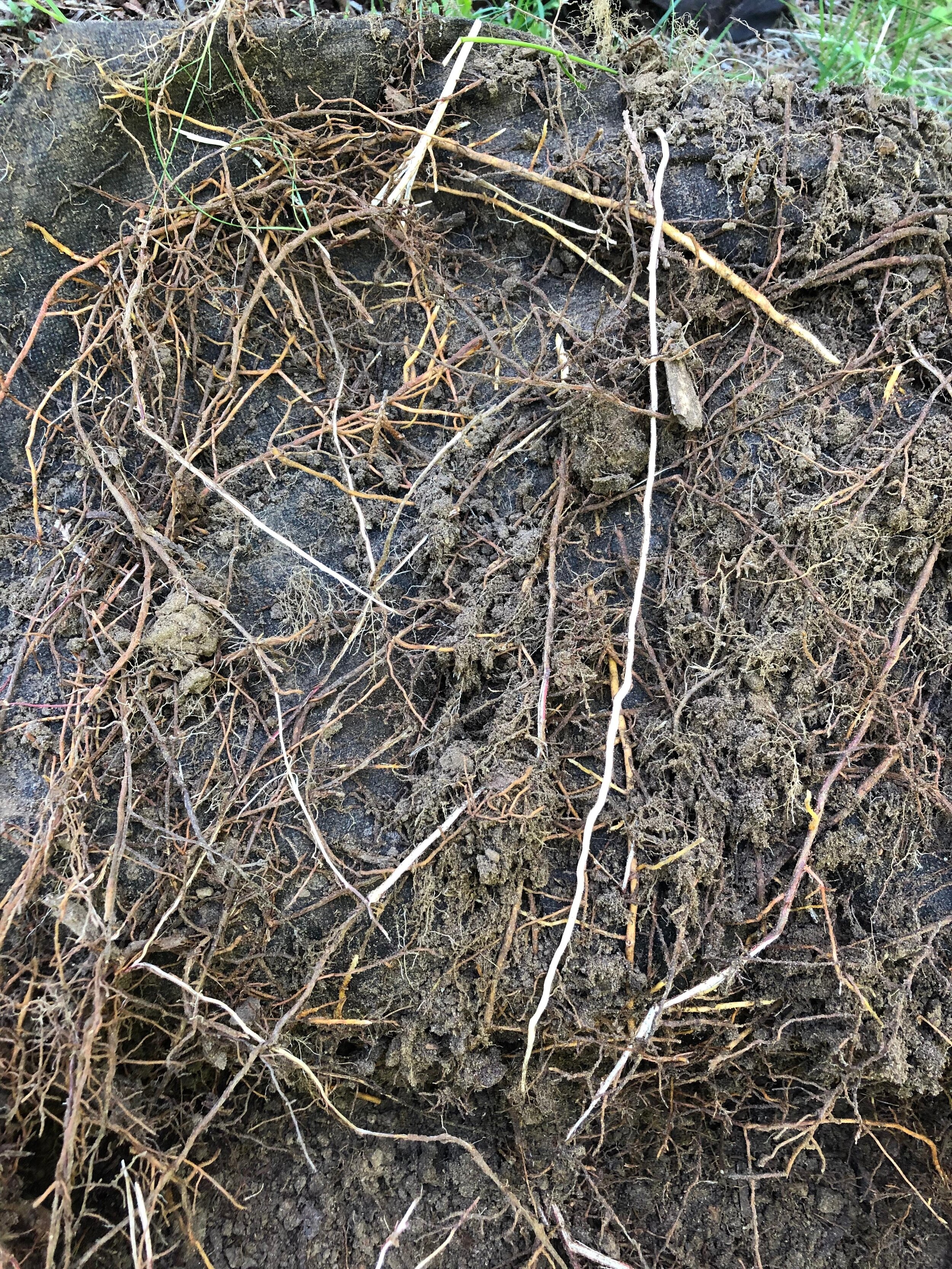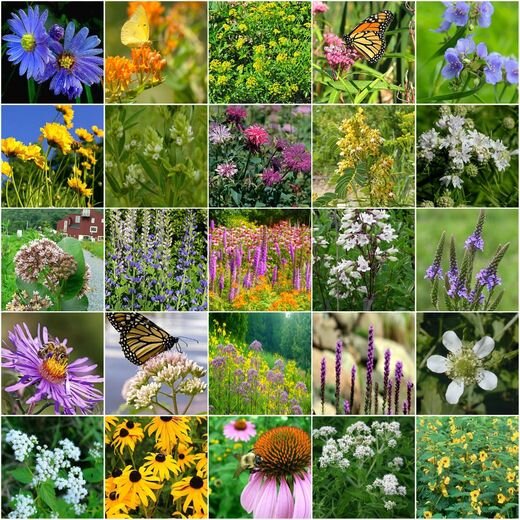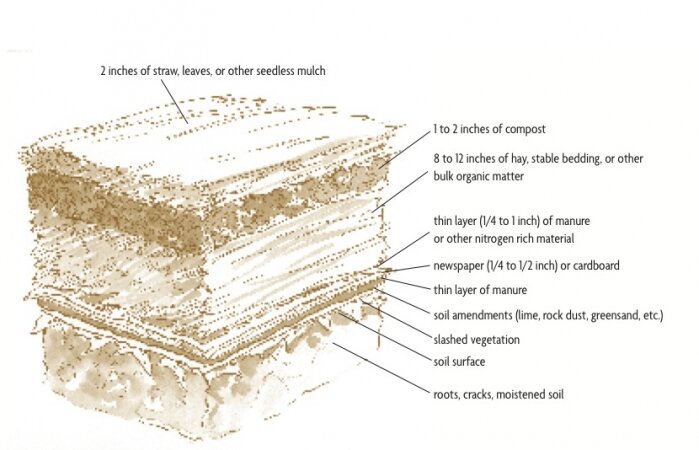Winter Interest With Earth in Mind
By Georgia Elgar
Our Yards and Gardens Matter. The midwinter freeze is upon us and the garden stewards here at Distinctive Gardening, Inc. have been using this time to take stock of our true role as gardeners. Those of us in the landscaping industry have an important role to play in creating human outdoor spaces that work with and mimic the nonhuman world. We carry enormous potential to be leaders in counteracting the entire array of global environmental crises: species biodiversity loss due to climate change, habitat loss due to development, and pollution of soil and water. This year, we at DG are committing even more deeply to lead the way in transforming our yards and gardens into sustainable ones.
How do we do this? Let’s look at a seasonally fitting example: What happens when we apply permaculture principles to the traditional concept of “Winter Interest”?
Ecological gardening need not be merely an ethical choice. It can be a positively aesthetic one! Often the best approach to gardening for nature is also the more beautiful and less laborious one.
Allow Grasses to Stand. At DG, we leave hardy perennial grasses up all winter long whenever possible to provide gorgeous windswept architecture to the landscape. Plus it’s one less fall clean-up chore! Even better, natives like Indian Grass (Sorghastrum nutans L.) can be used with pollinator-friendly wildflowers for a meadow look in summer and have a giant tolerance for poor soils often found in residential landscapes. Perennial grasses also serve to control wind and water erosion and provide excellent wildlife winter habitat and forage for deer and protection for insects and animals. http://www.nativegrasses .com/info/indiangrass.html
Perennial Color Too! Leaving the remains of garden staples like hydrangeas or natives like purple cornflower, beebalm, and sedums add a whimsical appeal to any winter garden! https://getbusygardening.com/winter-interest-plants/
Plant Winter Eye Candy. Many New England natives offer color and festivity in an otherwise white-brown winter schematic. The classics are lovely; winterberry and holly remain forever beloved, but less common choices like Yellow-Twig Dogwood (Cornus sericea) and Staghorn sumac (Rhus typhina) can be the native X-factor in your winter garden. Even better, they both provide especially powerful erosion control and are useful in reclaiming heavily-disturbed sites. Their strikingly colorful twigs, bark, and flower heads also provide winter browsing for deer, elk, moose, rabbits, as well as cover for many bird species. During the warmer months, dogwood is a larval host of the Spring Azure Butterfly and staghorn sumac is important food for many species of moths and butterflies, many of which are in decline.
Red-Twig Dogwood, Cornus sericea | Native Plants PNW; https://www.fs.fed.us/database/feis/plants/tree/rhutyp/all.html ; https://www.nny360.com/artsandlife/staghorn-sumac-a-beneficial-plant/article_6b0300f3-10ed-54c9-9fbe-6edd7f967590.html
Leave the Leaves. Leaf Litter is nature’s blanket! Except for disease-prone roses and fruit trees, leaving leaf litter and perennial remains on your garden beds until spring has countless benefits. It provides protection to beneficial wildlife, insects, and soil microbes. It provides some of next year’s plant nutrition as leaves compost into the soil. It reduces your garden’s reliance on fossil fuels since less clean up means fewer trips to the landfill and fewer hours on the backpack blower!
https://rubyleafdesign.com/tag/ecological-benefits/
Don’t be the last one to catch on to gardening beautifully while benefiting the land instead of harming it. Gone are the days of perfectly manicured beds, invasives, and fall cutbacks of everything in sight. Ecological gardening is here to stay.
When Your Weed Mat Becomes a Mat of Weeds
The appeal of weed mats or landscaping fabric is undeniable. Who wouldn’t want a ‘weed-resistant’ barrier between your soil and mulch layers? The reality is a little less rosy.
By Emily Macduff
The appeal of weed mats or landscaping fabric is undeniable. Who wouldn’t want a ‘weed-resistant’ barrier between your soil and mulch layers? The reality is a little less rosy. And over time, weed fabric cannot stand a chance against the power of nature.
The Promise
Retailers promise that weed fabric, primarily made from woven polypropylene, can be inexpensively installed to suppress weeds for as long as 20 years! The old adage ‘if it sounds too good to be true, it probably is’ rings true.
The Reality: Common Weed Mat Problems
At DG, we often meet new clients with well-established but weedy gardens in need of an overhaul. Where mat has been installed, we often find the weeds have densely intertwined their roots in the fabric. Remember: weeds are weeds because they are aggressive and adaptable. In the presence of a weed mat, they can use the woven plastic as a highway to spread further around the bed.
Planting: Planting new perennials in a bed with landscape fabric poses other problems. Digging and cutting some fabric years after its been installed can be difficult verging on impossible. The planting shown below was a struggle since there were areas where thick old weed mat existed up to 6 inches below the soil.
Plant Health: Long-established mats can inhibit or entwine with tree roots systems over time.
In serious cases like this you cannot expect to remove the weeds without also removing the fabric – often disturbing and exposing the remaining soil, which will then require compost and mulch.
Environmental Impacts
Weed mat products claim to allow water and air to permeate while reducing evaporation. However, in reality the artificial barrier can pack the soil beneath it and leave plants waterlogged and lacking oxygen. Weed barriers also interrupt the natural mixing of natural mulches (leaves; grass clippings) and essential microorganism among the soil, leading to depleted and nutrient-starved soil that is unwelcoming to most plants except – you guessed it – weeds.
Alternatives
So, what’s the alternative you ask? Skip the landscaping fabric altogether. If you’re installing a new bed, make sure you are planting in quality soil and mulch and stay on top of your weeding and cultivating, because either with or without fabric, you’ll need to weed!
If you’re installing a new bed, consider dense plantings of groundcovers as a ‘green mulch’ option. We love perennial geranium and barren strawberry, for example. The bed pictured below only has the occasional weed and it was only planted two seasons before the photo was taken!
Planting for Pollinators
Pollinators – the overlooked support crew behind every great garden – are essential in ensuring an abundant harvest of flowers and vegetables.
“The hum of bees is the voice of the garden” –Elizabeth Lawrence
It’s officially midsummer and by now your garden is likely bursting with new life. As a proud homeowner, you might spend several hours a week hauling watering cans, fertilizer and trellises back and forth. But are you taking care of your garden helpers? Pollinators – the overlooked support crew behind every great garden – are essential in ensuring an abundant harvest of flowers and vegetables. By rolling out the welcome mat to our winged friends, you’re not only helping your own garden but the entire food chain.
Honeybees may be the first that come to mind, but there are many more native pollinators to consider. Cultivating a pollinator-friendly garden will support native bees like mason, squash and digger bees; butterflies and moths; beneficial flies; hummingbirds, and even bats! These critters will help to sustain a diverse, balanced and abundant ecosystem in your backyard.
Pollinator-Friendly Plants (New England)
There are thousands of plants to consider when incorporating pollinator-friendly practices into your garden. By choosing locally sourced, non-invasive plants, particularly perennials, you are tailoring your yard to suit the wildlife and climate of your region, and potentially creating a space that is more low maintenance over the long term. Meanwhile, annuals are a great supplement that add an immediate pop of color (and pollen) to your outdoor space.
Tips & Glossary
Cultivars: a plant variety that has been produced in cultivation by horticulturists for selective breeding (does not generally produce true-to-seed)
Variety: a variety is a group of plants within a species that has one or more distinguishing characteristics and usually produces true-to-seed
Pollinators have a difficult time obtaining food from excessively hybridized flowers, so include cross-pollinated or heirloom options
Seek out single-flowering variety (such as rugosa rose), which have often co-evolved alongside pollinators, versus highly cultivated double/triple head flowers (such as an ornamental rose), as these generally produce less pollen and are harder for the insect to access
June/Midsummer Pollinators (not comprehensive):
Verbena hastata (Blue Vervain)
Aquilegia species (Columbine)
Dianthus species
Digitalis purpurea (foxgloves)
Fuschia
Eutrochium Eupatorium maculatum (Joe Pye Weed) *Great for Monarch Butterflies!
Monarda species (Bee Balm and Bergamot)
Lobelia cardinalis (Cardinal flower)
Petunia
Rudbeckia (Black-eyed Susan)
Echinacea (coneflower)
Symphyotrichum (aster/daisy family)
Salvia
Baptisia australis (blue false indigo)
Cosmos
Achillea (Yarrow)
Coreopsis (tickseed)
Zinnia
Nasturtium
Rose species
Extend Nectar Season
Your local pollinators are true workaholics, so they benefit from a multi-season buffet. To achieve this, you can think about planning your garden to include a variety of early, mid and late season blooms. Not only will this increase biodiversity, it also means an ever-changing garden palette. You can easily find bloom season information on the back of the seed packet or nursery tag.
Chemical-Free Zones
The well-publicized decline of the honeybee reflects the wider crisis facing the insect world – loss of habitat and widespread pesticide use have decimated populations. On a personal scale, you can mitigate this damage by opting to avoid the use of synthetic chemical pesticides all together or choosing a safe, natural alternative.
At Distinctive Gardening we are concerned by the risks posed to humans and wildlife by widespread chemical pesticide use. That is why we are certified organic specialists and use only organic, natural materials in our work.
Welcome Home
It’s not just about creating a good place to collect nectar – pollinators are intensive workers that need shelter and water to survive. You can create a sanctuary by providing an open water source for drinking, hanging hummingbird feeders, and creating “bee hotels.” Put simply, a bee hotel/house is a structure comprising small, partially sealed spaces for native bees and insects to rest safely.
You can create an all-natural, biodegradable bee house using material widely found in the garden or natural spaces. Look out for our next blog post outlining how to create your own bee house for free!
Coming Soon to the Blog: Make Your Own Biodegradable Beehouse!
Growing Toward the Light: Starting Your Vegetable Garden
While the world around us feels increasingly uncertain and chaotic, Mother Earth’s natural rhythms continue on unchanged. It’s officially springtime in New Hampshire; the days are getting longer, the first spring shoots are popping up, and the time to plant garden vegetable seeds and seedlings is upon us.
“Busy hands and idle minds have knitted many a sweater; Busy minds and idle hands have knitted many a brow.” Maryrose Wood, Author & Amateur Gardener
While the world around us feels increasingly uncertain and chaotic, Mother Earth’s natural rhythms continue on unchanged. It’s officially springtime in New Hampshire; the days are getting longer, the first spring shoots are popping up, and the time to plant garden vegetable seeds and seedlings is upon us. Many among us are experiencing increased frustration or anxiety, and have extra time to indulge these worries. Instead, why not think about starting your own vegetable garden? There has never been a better time to think about self-sufficiency and food security. Getting your head and hands buried in garden planning is just the thing to bring some light, joy, and creativity – not to mention fresh produce – into your life!
Before You Begin Your Veggie Garden
At Distinctive Gardening, our growing season is shaped by New England’s distinct seasons and short growing calendar. Starting your vegetable garden begins with understanding your environment. What hardiness zone do you live in? What is this year’s predicted first and last frost date? Annual rainfall and sun days? Armed with this information, you’ll be better equipped to read seed pack instructions and plan your garden successfully.
Planning Your Veggie Garden: Site, Supplies, Crop Choices
Site: Depending on the space you have available, you may choose between gardening with containers and pots, a raised bed, or turning over a patch of soil.
Containers and Pots: Even if you live in the city, you can still grow your own fresh produce right from your home. Whether you’ve got a balcony, porch, or just a sunny, south-facing windowsill, lettuces, herbs and even tomatoes and peppers are all in the realm of possibility!
Raised Bed: Perfect for the compact yard, growing veggies in a raised bed allows you to work with fertile, fluffy soil that warms up more quickly in the spring. Plus, it means less distance to bend for planting, weeding, and harvesting. You can make your own 4x4 raised beds on a budget.
Turning a Patch of Soil: Your goal is a sunny, grass-free, root-free rich soil medium with adequate drainage to work with, at least 6-8” deep, and ideally not too sandy or clay-heavy. This may be accomplished with a shovel, rake, and some elbow grease, a rototiller, or you may even consider this easy “lasagna” gardening method. Once, you know what space you are working with, draw a simple sketch of your plot and a wishlist of vegetables you’d like to see on your table this summer.
Supplies: Essential items will need to be sourced if not borrowed. While the big box stores might seem like a one-stop-shop, consider your local nursery and farmers instead. Small businesses need our support more than ever right now, and local nurseries generally provide a higher-quality product that is suitable for your climate. Here are the essential items to begin your garden:
Soil – potting soil for containers, garden soil for your raised bed
Containers/pots - Get creative before heading to the store. Do you already have something on hand in your basement or back porch? Does your neighbor?
Seeds and seedlings. Check your local farmer’s markets, nursery or scroll below for our list of suggested seed suppliers.
Additional compost/manure for your raised beds and garden plots.
Watering can or hose with sprinkler nozzle
Shovel and trowel
Gardening gloves, if that’s your thing.
The Best Part: Choosing Your Crops
Just 200-square-feet of productive garden can be enough to feed one person year-round. However, anything you can grow to supplement your kitchen is worth your time and energy. Once you’ve tasted your first home-grown, sun-warmed tomato there is simply no returning to lesser store-bought varieties!
Here are some great veggies to begin your vegetable growing journey:
Tomatoes*
Lettuce*
Spinach
Radishes
Kale and Swiss chard*
Beets
Peppers*
Cabbage*
Potatoes
Cucumbers*
Summer squash and zucchini*
Onions from “sets”
*These crops are generally available at garden stores/nurseries as transplant starts. Others should be directed seeded into your garden.
My Seeds & Starts are In – Now What?
Lots of questions start to arise when you begin getting your hands dirty. The good news is, people have been growing food for a LONG time. See below for a list of useful resources to help guide you and subscribe to our blog for future posts on a variety of garden topics. And remember to look within your community: neighbors, local farmers, green professionals, and amateur growers can be reached over the phone and on social media. During this difficult time, these connections can be as vital for us as for the plants.
We may not be able to plant toilet paper trees, but we most certainly can grow some juicy tomatoes, crisp greens, and pungent onions. May you all have brilliant green thumbs this season!
❧
Useful Resources:
Local Seed and Plant Sourcing:
Spider Web Gardens, Tuftonboro, NH
Petal Pushers Farm, Laconia, NH
Wayside Farm, North Sandwich, NH
Johnny’s Selected Seeds, Maine
Growing Information:
Northeastern Organic Farming Association of New Hampshire
SiGN Up & SHARE
Interested in organic gardening? We are hiring in Maine!
Come garden with us!
Come join our gardening gang... Work outside with plants and soil alongside great people!
If you have gardening experience and live in the Portland, Biddeford, or Kennebunk areas, please email us your resume - we are hiring gardeners starting this spring: info@distinctivegardeninginc.com
Native plants
planted and cared for
Mixed borders
designed and maintained
Some wild
but carefully managed
Edible gardens
our newest venture -organic of course!
Come see us at the Maine Flower Show 2019!
In 2017 our "Rustic and Repurposed" garden, in collaboration with Boiling Spring Landscape and Gogan Landscaping, won the "Plants for the Kitchen Award", and tied for the "Pollinator Award"!!!
































